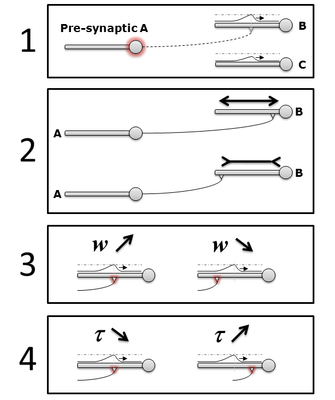Local learning rules for spiking neurons with dendrite.
Olivier F.L. Manette (CNRS)
We present in this abstract four local rules to train a network of spiking neurons with dendrite. After training, every neuron of the network becomes specialized for a particular feature of the input signal. This network, with these rules, acts as a features extractor where each neuron contains a vector of TAND. TAND are like logical AND with the information about time between the two events in the input signal.
The neuron model used here has one single dendrite. All the synapses are connected at different position along this dendrite. Synapses are only located on the dendrite and never at the soma. When a synapse is activated, it triggers an EPSP that is propagated with attenuation and delay towards the soma. EPSPs amplitude loses as it propagates. Time constants of EPSPs become larger as it spreads. All the different EPSPs from the different synapses are summed and are propagated to the soma. If this sum reaches a threshold then the neuron spikes. Spikes are always and only emitted at the soma and never at the dendrite. The EPSP used here in this model is a particular solution of an alpha function.
We have two
rules of morphological modifications and two rules of synaptic
electrophysiological changes.
1) Create a new connection between two neurons: Every time a neuron is
activated i.e it emits an action potential (spike) it will try to create a new
connection on the most activated neuron of its pool of neuron. It will create a
new synapse on the dendrite of this most active neuron at the exact position
where the membrane is most depolarized.
2) Changing the dendrite length: A
neuron always creates a new synapse at the max local activation. If this max is
located at the soma or at the dendrite but directly next to the soma then, the
dendrite is first elongated and the rule #1 or the rule #2 will be applied the
next time the local threshold will be reached on this neuron.
3) Modification of synaptic weights: The weight is increased if the neuron is
locally depolarized over a synapse position while this synapse is also
activated. This weight is decreased if the neuron is locally depolarized after
the synapse location relatively to the soma while this synapse is also
activated.
4) Changing the time constants: The time
constant of the EPSP determine the duration of the EPSP i.e. it determine the
accepted temporal precision of the incoming spike. If a synapse is
systematically active when the membrane potential is depolarized at the synapse
position then the time constant will be reduced. Conversely, the time constant
will increase if the synapse is always active before the membrane potential
reaches is depolarized over this synapse.


 Latest news for Neuroinformatics 2011
Latest news for Neuroinformatics 2011 Follow INCF on Twitter
Follow INCF on Twitter
